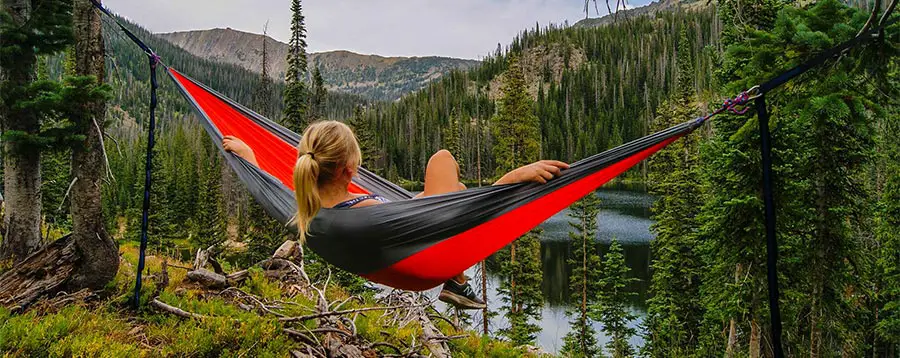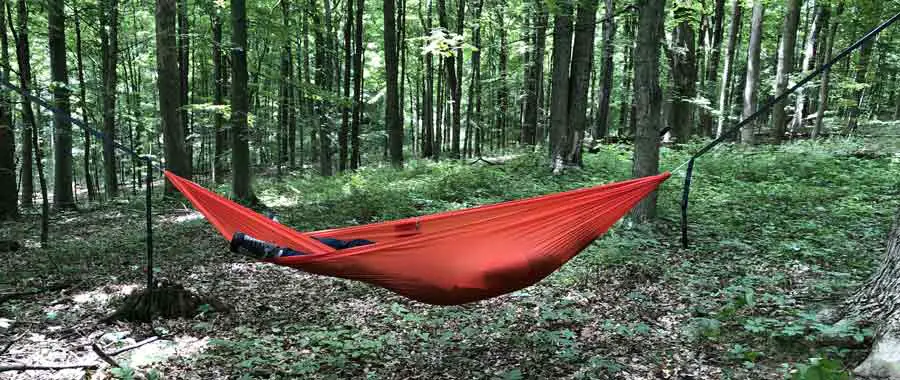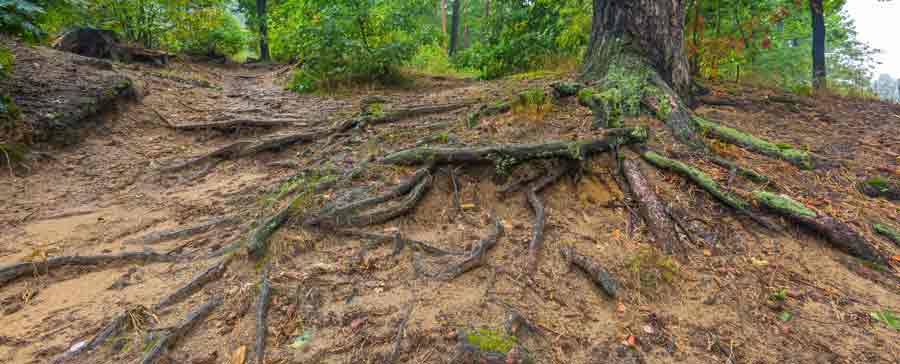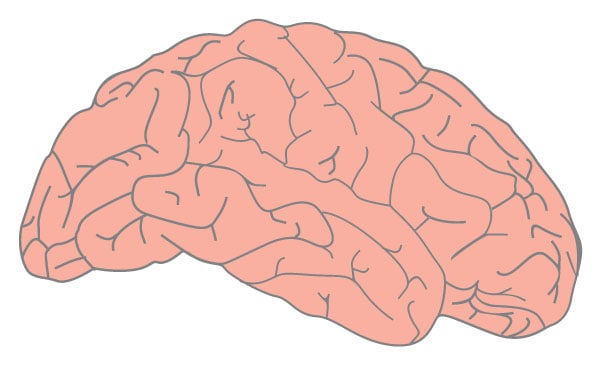“A hammock, huh? It can’t be comfortable to sleep like that is it?” This is one of the most frequently asked questions I get whenever I am having a conversation about hammock camping. Everyone is always intrigued when I mention that I sleep in a hammock rather than a tent when I go camping.
Is sleeping in a camping hammock comfortable?
Yes, sleeping in a hammock is very comfortable. There are many health benefits associated with sleeping in a hammock. Recent studies cite that you fall asleep faster and achieve a deeper sleep. The angle of your body while sleeping in a hammock is also beneficial – better circulation of your blood and lymph. With this, your brain even detoxifies itself through the glymphatic system, which allows you to wake with more energy.

Hammock Comfort
I’ll be honest, when I bought my first hammock, I wasn’t entirely convinced that I would be comfortable or even be able to get a good night’s rest. To say the least, I was skeptical. However, I was extremely intrigued by the idea of hammock camping and the fact that I would be leaving a smaller footprint and have a lighter pack to carry. I was willing to sacrifice my quality of sleep just for those two reasons alone.
My intention for this blog is to provide my honest and unbiased opinions – even if it may paint hammock camping in a negative light. As with anything in life, hammock camping, or really any type of camping, has its pros and cons.
So as promised, I’ll be truthful…the first night I slept in a hammock was not the most peaceful night of my life. It certainly was not the most comfortable rest I’ve ever had.
I was diligent about researching all the gear and equipment I would need to successfully hammock camp. Except, I left one vital topic out of my research
HOW to sleep in a hammock
I thought I could just jump right in there and fall fast asleep. Wrong. That’s right, there’s apparently a learning curve to sleeping comfortably in a hammock that I was completely unaware of. Looking back, I realize that experience was the greatest teacher, but I really wish I had known about it ahead of time.
The morning after my first hang was a little disappointing, but I wasn’t discouraged. It took me a couple of nights to adjust and figure out what positioning worked well for me. Not everyone can sleep in the same position so what works for one person may not work for another. Once I found my ‘sweet spot’ positioning, there’s no way I will go back to tent camping. I get my very best sleep in my hammock now. Even better than my bed at home.

As you can see, when people ask me if sleeping in a hammock is comfortable, it’s a loaded question. I am always sure to answer, “Yes, it’s extremely comfortable, BUT…” and then give the caveat of making sure to practice sleeping positions and find your ideal configuration.
The cool thing is, there is no right or wrong way to sleep in a hammock. You can get as creative as you want to. You do you. Whatever position is comfortable for you may not be what is comfortable for your hiking buddy. That’s okay. Every person I’ve ever talked to about the quality of sleep they get in a hammock says they get fantastic sleep once they figured out how they like to sleep. As a warning, you will be disappointed a few times, but don’t get discouraged if you haven’t found your ideal comfy positioning, it will come with practice and time.
Find a Comfortable Position in your Hammock
Proper set-up for your hammock includes both the angle from which you hang as well as the position in which you sleep. Your quality of sleep is dependent on both of these factors.
Sleep parallel or perpendicular to the trees?
Some people enjoy sleeping parallel to the trees while others would rather sleep a little flatter. If you want to sleep flatter, you will need to adjust your body angle to turn yourself more perpendicular to the trees – the more perpendicular you get, the flatter your hammock will be. If sleeping flatter is more your style, double hammocks are usually best for this as they have more space to stretch out. This often takes some experimenting to get right, but it’s totally doable.
Preferred Sleep Position
Your sleep posture also has a lot to do with your level of comfort while sleeping in a hammock. Most of us have a natural preference when it comes to sleep position – side, back, stomach, or any combination of the three. For some, their normal sleep posture works for them when they sleep in a hammock, but others may have to adjust and sleep a little differently than they are used to.
The best way to figure out what will give you the comfort you desire is to experiment and don’t give up after just one or two nights.
Your Hammock Sleeping System
There are other factors that you need to consider such as insulation systems – sleeping bags, underquilts, sleeping pads, blankets etc. There are so many combinations for adding insulation and comfort to your hammock.
You will need some kind of insulation if you are sleeping in your hammock overnight. Heat transfer in a hammock is different and you will need something to keep you warm in temperatures 70 degrees and below. Underquilts and sleeping bags are usually the first thing people think about when they need insulation, but there are many ways to insulate your hammock for ultimate comfort. I’ve tried a lot of insulation systems in various situations, weather, and temperatures. I’ve done it on the cheap and I have also invested in gear. I’ve shared several alternatives to underquilts and sleeping bags in other articles.
YOU MAY ALSO ENJOY:
Avoid Ground Discomfort with Hammocks
The ground always wins. What do I mean by this? Well, anyone who’s slept on the ground in a tent where there is some kind of stump, root, rock, etc in the middle of your back all night knows this – the ground can be an unrelenting pain in the butt..urg…I mean back.

Hanging in a hammock? Not a single root, stump, rock, or any other “Princess and the Pea” type natural element to bother you. As a bonus, you don’t ever have to worry about being startled awake because you are lying in a puddle of water. Nope. Doesn’t happen in a hammock.
Fresh Air
The fresh air that flows into my hammock is so much better than breathing the recycled air inside a tent. Some nights the air is crisp and clean. Maybe it’s just me, but I enjoy breathing fresh air. I feel like it helps me get better sleep as well.
There’s something to be said for sleeping under the stars and falling asleep while stargazing. Sometimes it feels surreal. I’m not trying to paint a picture for you, but there’s a certain comfort when you are just listening to the sounds of the wilderness and looking up at the stars. It’s so relaxing and soothing.
Hammock Sleep is Healthy Sleep
Hammocks have been used by many cultures and groups of people throughout history. They had it figured out long ago – hammocks were the way to go. There are many other cultures that slept, and some that still sleep, in hammocks every single day. It’s fascinating, really.
Increased circulation
Sleeping at an angle during the night promotes better circulation of blood and lymph throughout your body. Why is this a good thing? Well, we all know proper blood flow is essential for a healthy body. No one really disputes that. When you have good circulation and your blood is flowing, your skeletal muscles benefit. The increase of oxygen and nutrients promotes healing throughout the body as well.
Your body will need some healing and good blood flow after a long hike. After sleeping in your hammock, you will wake up more refreshed than if you slept on the ground. Your body was in super healing mode during the night and working hard to soothe those sore muscles. I have personally felt the difference. I always feel better after sleeping in my hammock vs my tent.
The lymph system can also work optimally while sleeping at an angle. Lymph is the fluid that contains white blood cells that drains out into to bloodstream via the lymphatic system. Lymph protects the body from bacteria and fights infections. Proper drainage of lymph is crucial for keeping a healthy body.
Promotes brain health
Personally, I like my brain and anything I can do to make it even more awesome, I will do it. That might just be my brain talking though. *ba dum chhh*

Anyway, on a more serious note – being in a hammock and at an angle does promote brain health. Just adding five degrees of incline can do the trick. Luckily, that’s about the incline you get in a hammock. The slight angle of sleeping in a hammock allows your brain to do a few things. When you sleep, your brain actually shrinks a little. There’s sciencey stuff as to why this happens, but in a nutshell the brain shrinks itself in order to wash in cerebrospinal fluid. This wash moves all of the waste from your brain into the peripheral lymph. Starting to see the connection? Being in a hammock at even the slightest five-degree angle promotes the glymphatic system to drain downhill for an easier flow. Your glymphatic system is the clearance pathway to clear waste from your central nervous system. The brain gets rid of nasty stuff each night like heavy metals, pathogens, and other bad stuff and sends it to the gut so it can be gotten out of the body. The brain is pretty awesome.
You didn’t expect a super science explanation out of this, did you? There are lots of great sleep studies on hammocks that explain this whole process in great depth.
YOU MAY ALSO ENJOY: Do You Need a Pillow in a Hammock?
So is Sleeping in a Camping Hammock Comfortable?
In my humble opinion, not only is sleeping in a hammock comfortable, but sleeping in my camping hammock is the best sleep I get anywhere – hands down. I am always full of energy and ready to go for the day after I’ve had a good night’s rest in my hammock. I honestly, can’t say the same for my own bed. Just ask my wife. If I could (and she wouldn’t get upset with me) I would hang a hammock in my bedroom and sleep in it every single night of my life. Not super great for marriage though, you know?
I hope I have at least given you some good nuggets of info on this topic. If you leave with anything, I hope it is that you will practice finding your ideal sleep style.
Here’s to sleeping like a baby!
As always, get out there and enjoy the Wanderful Wild
Brain shrinks article:
https://www.sciencedaily.com/releases/2013/10/131017144636.htm
Circulating blood and lymph articles:
